The Top of the Funnel Problem: An Underrated Opportunity
Prospects who are beginning to research a problem are the furthest from making a purchasing decision, so many companies ignore targeting these prospects altogether.
Instead, most companies concentrate their resources on attracting prospects who are already educated on the problem and who are closer to making a purchase.
As a result, top of the funnel traffic is often much easier and cheaper to acquire, meaning you can build a relationship with these prospects and ultimately convert them much more profitably.
A strong top of funnel acquisition system also means you’ll have a full pipeline of prospects moving into your middle of the funnel and bottom of the funnel stages so that you aren’t as reliant on paid ads and organic rankings for specific high purchase intent keywords.
In this post, we’ll discuss the top of the funnel problem in more detail and explore various strategies to drive more quality top of the funnel traffic to help you acquire customers more profitably.
What Is the Top of the Funnel Problem?
The marketing funnel is broken into three different stages: the top of the funnel (TOFU), middle of the funnel (MOFU), and bottom of the funnel (BOFU).
TOFU is the awareness stage of the buyer journey. At this point, potential customers are actively or passively learning about a particular problem and solutions, but they aren't ready to buy.
Therefore, the TOFU audience often makes up the largest percentage of the marketing funnel. At this point in the buyer journey, users are just educating themselves, so most content is relatively introductory and beginner level. However, this content is important because it plays a critical role in building trust with the audience.
Below, we'll discuss why it's important to nurture top of the funnel audiences, how to drive more top of funnel traffic, and how to convert them into MOFU and BOFU audiences that ultimately become customers.
Why Should You Care About the Top of the Marketing Funnel?
TOFU audiences are furthest from the purchase decision stage, so many brands ignore the top of the funnel and only target MOFU and BOFU visitors.
However, these marketers often have high customer acquisition costs, longer buying cycles, lower conversion rates, and empty prospect pipelines.
This is because the customer journey is a long winding path with many touch points – not a linear three or four-step process. Therefore, addressing the TOFU audience helps you earn those touch points and build the customer relationship at a lower cost before they turn into high value, bottom of funnel prospects.
Below, we'll discuss how nurturing a TOFU audience can help you achieve your marketing goals more effectively.
Increase Traffic, Brand Awareness, and Authority
Targeting top of funnel traffic is typically less expensive (e.g., more impressions, website visitors, etc., for every dollar invested) than middle and bottom of funnel traffic because these users have lower purchase intent.
The good news is that this means TOFU content is a great opportunity to increase brand awareness among your target audience at a fraction of the cost. When prospects see your brand virtually everywhere during their initial research, your brand earns credibility.
As a result, visitors are more likely to return to your brand when they're ready to make a purchase decision.
Better yet, search engines and even industry experts will also begin to recognize your brand as an authority in the space, leading to more organic brand mentions, higher rankings in search engines, and even more partner collaboration opportunities.
Increase Engagement
If you think about the social media posts that earn the most engagement, it's usually general educational posts, opinion-based posts, and stories – not case studies or white papers.
Alex Hormozi, owner of a $100 million plus portfolio, has built his brand on top of funnel social media content, like this post:
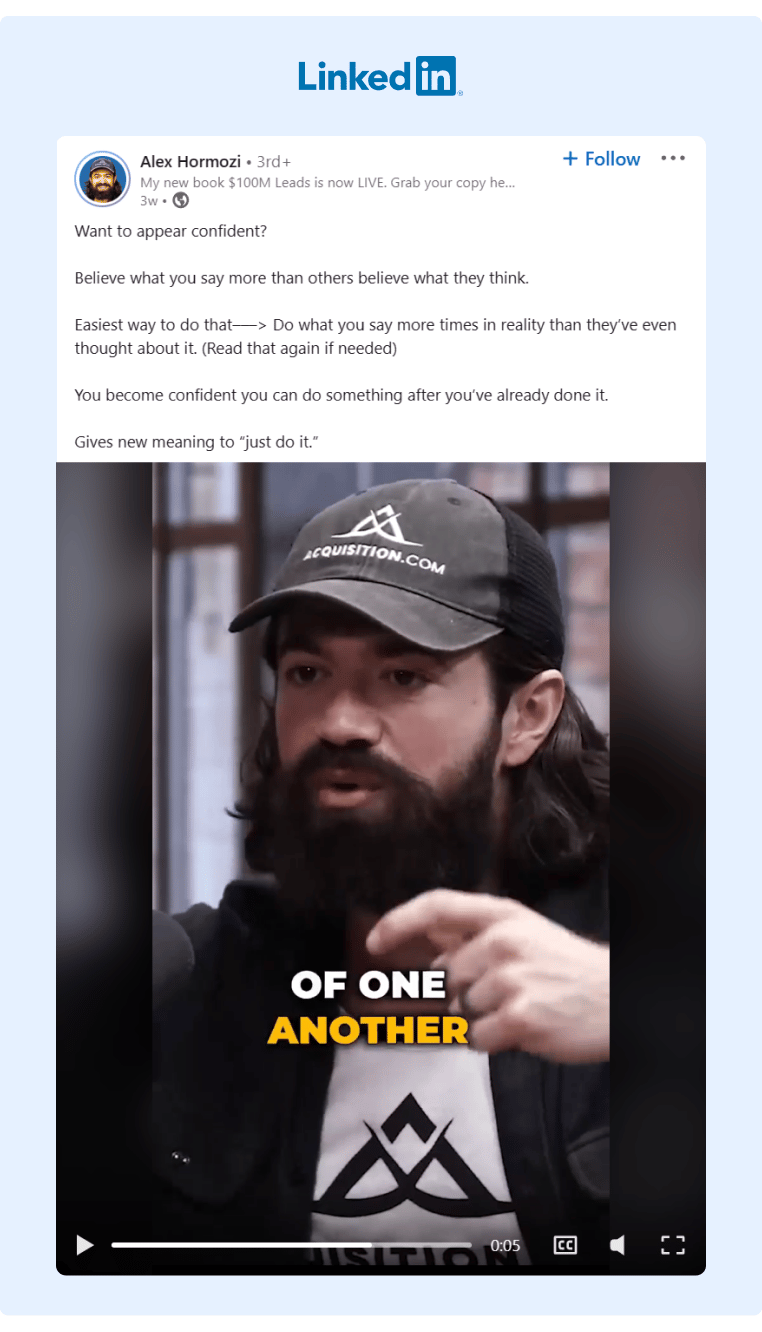
Source: Alex Hormozi
He’s personally stated that the engagement and credibility earned from this kind of content has been critical to filling both their talent and sales pipelines.
Earn More Referrals
TOFU content helps you earn more general brand awareness, and when your brand name is constantly top of mind with your target audience, it's much more likely your audience will organically mention the brand name in conversations and word-of-mouth referrals.
In fact, even if someone has never been a customer of your brand before, they might mention your brand name if a friend is asking for a solution like the one that you offer.
Decrease Paid Media Costs
Before a potential customer converts, they need to build trust with your brand and believe it will solve their problem.
Unfortunately, each touch point with your brand costs money (either through paid media or content creation), though the price of attention is much lower at the top of the funnel than at the middle and bottom of the funnel.
So, if you earn those touch points and build the relationship at the top of the funnel, your middle and bottom of funnel campaigns will convert at a much higher rate than if you don't build trust at the top of the funnel.
As a result, top of the funnel marketing can significantly reduce your paid media costs.
Better Understand Your Audience
If you create top of funnel content, you can see which topics, trends, or ideas resonate best with your audience.
You can then use that information to craft your MOFU and BOFU campaigns.
For example, if you notice that your blog post on setting up Google Analytics 4 generated a lot of comments and questions, you might consider running ads for that topic and creating a template or white paper that answers the more advanced questions your audience asked after reading the blog post.
How To Drive More Top of the Funnel Traffic
You can leverage multiple channels and mediums to earn more awareness and traffic at the top of the funnel. Here's an overview of some of the most effective mediums with examples to inspire your next TOFU campaign.
Earned Media
Earned media are organic brand mentions that were not paid for or produced by your brand. Instead, this media was created and published by a third party, like an influencer, blogger, or customer, without any incentive from the company.
Some examples of earned media include user generated content published by an influencer, an organic brand mention in an industry publication, and a customer providing a testimonial of your brand at an event.
Here’s a great example of earned media for newsletter platform beehiiv:

Source: Avi Gandhi
Paid Media
Paid media can be Google ads, social media ads, podcast ads, or any other type of media where you pay to get in front of an audience on a specific platform. Paid media can also include influencer marketing or paid PR mentions.
While you can use paid media for any stage of the funnel, the content that you're driving your audience to determines whether it's a BOFU, MOFU, or TOFU paid campaign.
An example of a TOFU paid media campaign might be driving LinkedIn ads to a blog post on brand awareness, whereas a BOFU paid media campaign might be retargeting people who have already downloaded an employee advocacy white paper.
Here's an example of a TOFU paid media campaign from Semrush:
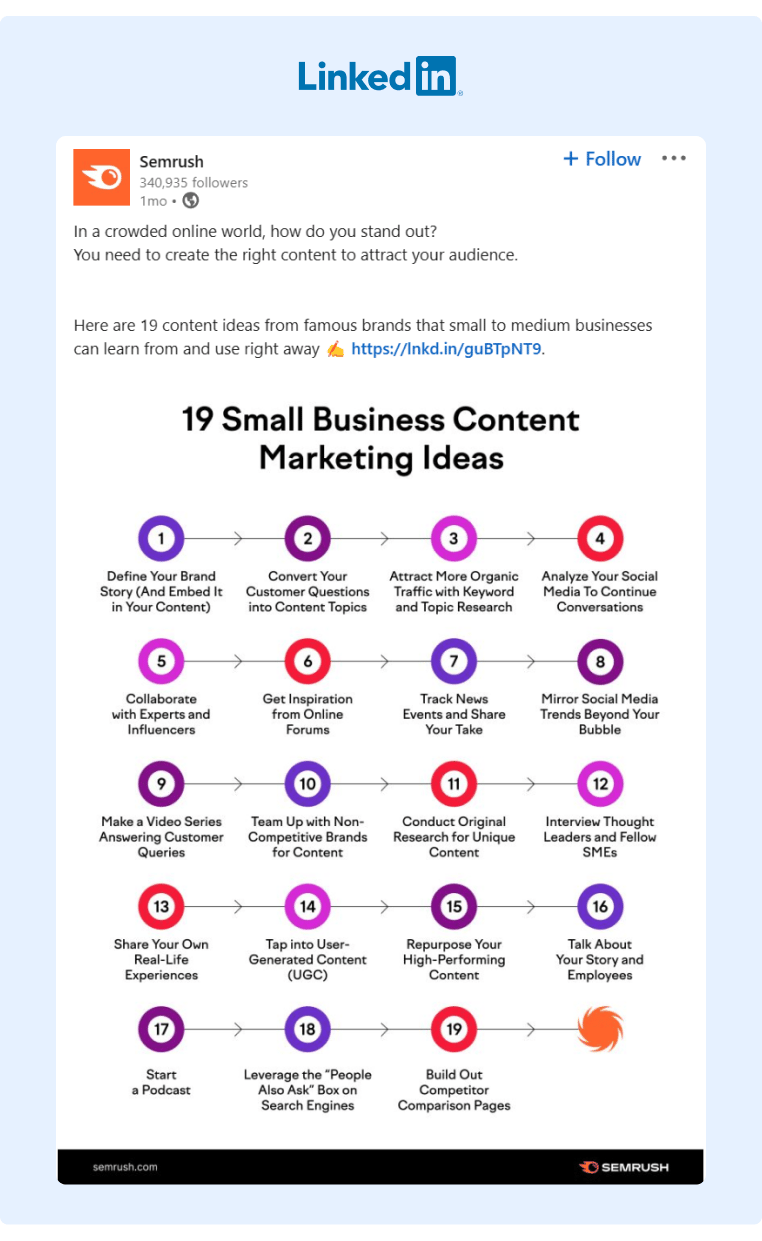
Source: Semrush
Owned Media
Owned media is content produced by the brand.
Some examples of owned media at the TOFU stage include educational blog posts targeting awareness level keywords, social media posts discussing general industry trends, or helpful infographics and checklists.
Again, the key to making owned media TOFU is to ensure it's educational rather than selling the product or service.
To give you an example of owned media, check out our blog, social media accounts (X, LinkedIn, etc.), or even sign up for our email list.
Employee Advocacy/Shared Content
Employee advocacy is a form of media where the employee shares content (typically on social media) about the brand they work for with their network.
Here are a few examples of TOFU employee advocacy:
- An employee sharing a story about their experience working with the company.
- An employee sharing a recent project they’re working on at the company.
- An employee sharing a company milestone or award.
- An employee sharing a meme about their company.
Here’s a great example of TOFU employee advocacy where the employee shares a few features that they love within the product:
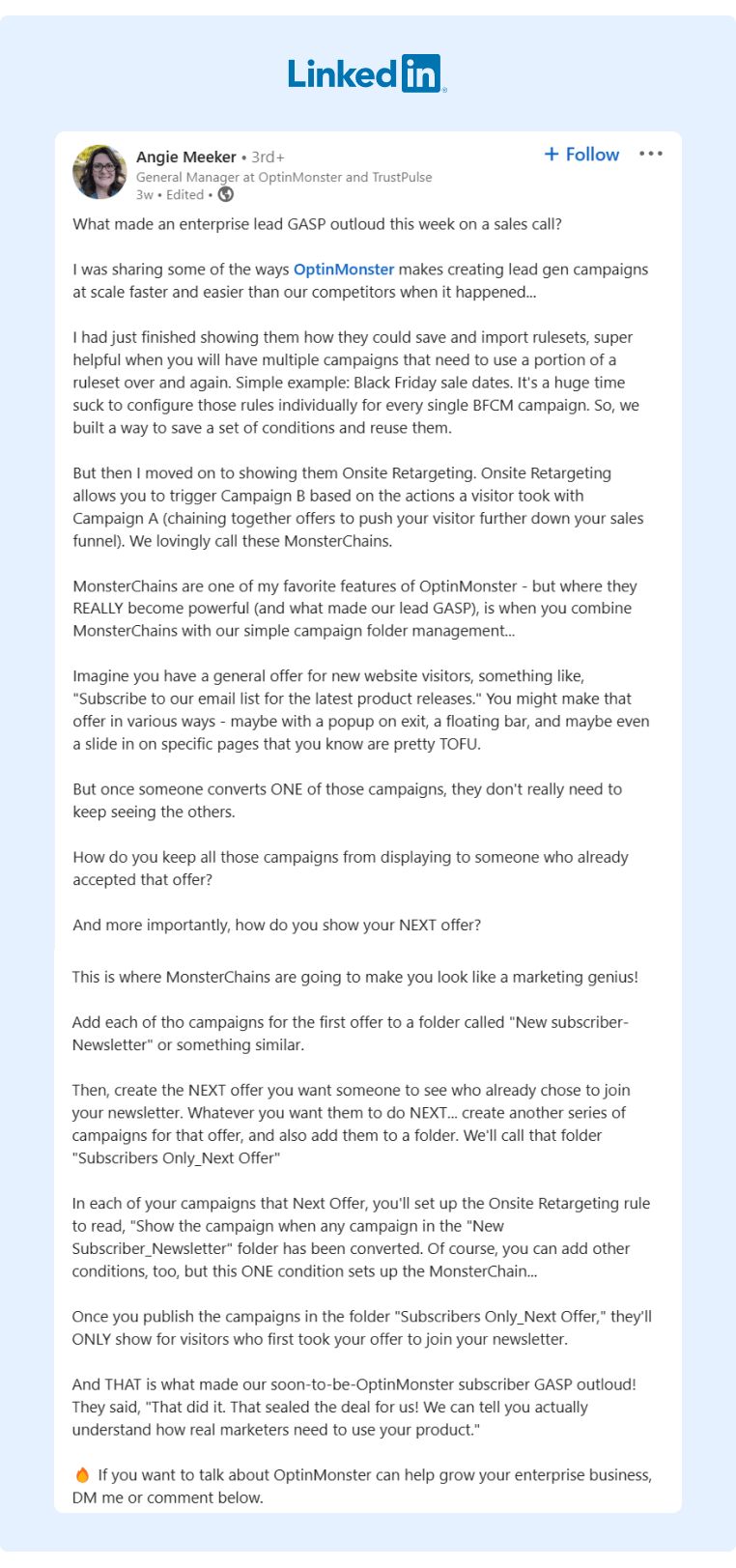
Source: Angie Meeker
She also published another employee advocacy post about her experience at the company’s team retreat:
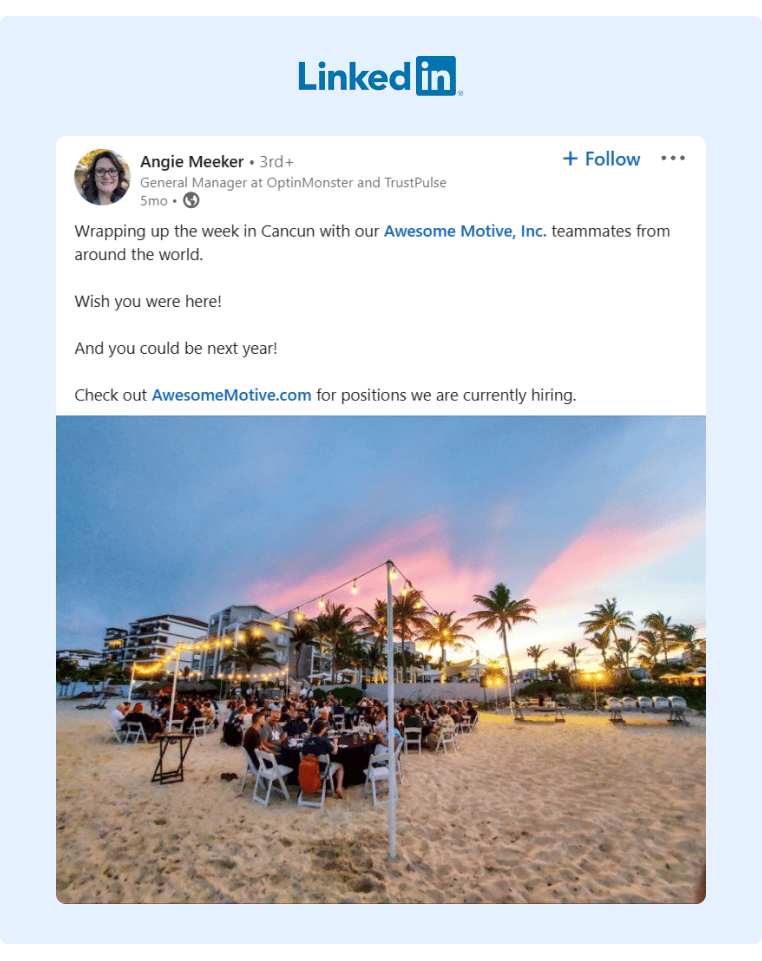
Source: Angie Meeker
Converged Media
Converged media combines earned media, paid media, owned media, and shared media. Using these channels together creates compounding results, as each has unique benefits and drawbacks.
For example, owned media typically takes longer to produce an ROI yet delivers higher returns in the long run. On the other hand, paid media produces a fairly immediate ROI yet delivers zero returns once you turn the campaign off if you don't capture the traffic through other channels.
Source: School of Marketing
Therefore, converged media is critical to your TOFU strategy for 2024.
How to Leverage TOFU Content
Your TOFU content aims to attract the right audience by creating educational and/or entertaining resources around the general pain point your product or service solves.
Each touch point with your content builds trust so your brand is top of mind when they are ready to purchase.
As a result, you'll have much higher conversion rates when you offer a product or service to your audience. However, it's important to remember that the goal of your TOFU marketing efforts are strictly to attract the right audience and build trust.
To help you build this audience, there are multiple forms of content you can use, including:
- Podcasts.
- Webinars.
- Video.
- Social media content.
- Blog posts.
However, creating content for each of these channels is resource intensive and can be exhausting.
Instead of creating a variety of new content for each channel, create just one pillar piece of content and then repurpose it across all other platforms.
Alex Hormozi (mentioned earlier) is also a highly effective content repurposer.
For example, he often records a single video and then his team repurposes it into a long-form video on YouTube, a podcast episode, short form video content, and even text-based social media content.
As a result, he can create 10 or 15 pieces of content from a single creative session.
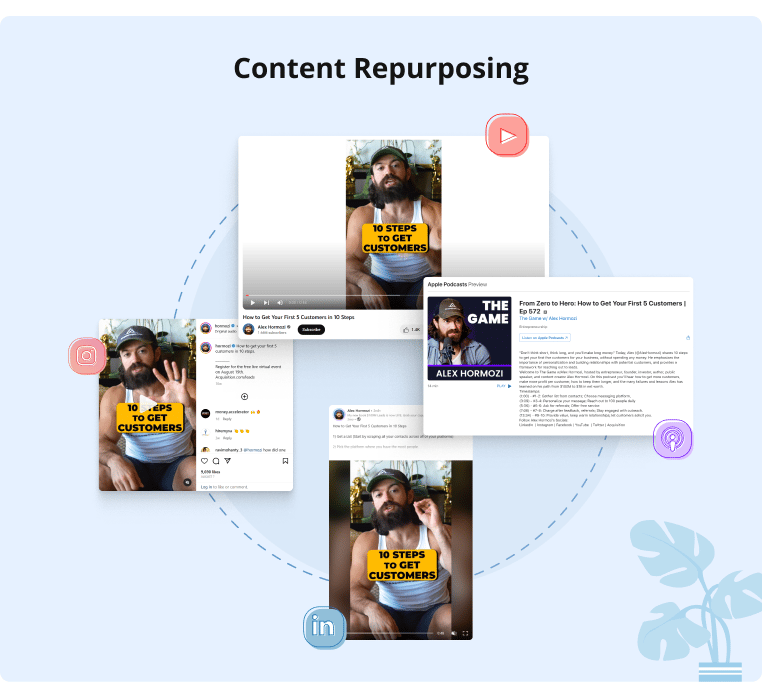
Sources: Alex Hormozi’s YouTube, Apple Podcast, Instagram, LinkedIn Platforms
The example above is also TOFU content, as it provides high-level educational business tips for beginners.
Even though his ideal prospects are high-level business owners, he understands that playing the long game and building awareness at the top of the funnel stage will help him earn the trust of these entrepreneurs at the beginning of their journeys. It will also ultimately help him acquire more businesses when they reach the middle and bottom of the funnel.
Moving Your TOFU Audience to the MOFU Stage
Many marketers ignore the top of the funnel stage because they know that these visitors don't convert into customers.
This is true.
Your top of the funnel audience won't purchase your product or service unless you move them to the next stage of the funnel.
The good news is that if you have an effective top of funnel marketing strategy and can effectively move them through the rest of the funnel, you'll have a predictable stream of steady leads.
So, how can you convert TOFU audiences to the next stage of your funnel?
First, be sure you're using relevant TOFU channels like SEO, social media, and other channels to capture attention.
Then, identify the additional content your audience wants after consuming your TOFU content.
A common mistake marketers make is automatically asking TOFU audiences to take a huge leap, like scheduling a demo, when they still want to learn more about their pain point and your brand's solution.
Therefore, each piece of TOFU content should direct them to a piece of MOFU or BOFU content that discusses how your product solves the general pain point your TOFU content discusses.
For example, if you offer a social media management tool and the TOFU content you produced is a blog post on brand awareness, the next step would be to direct them to a piece of MOFU content that shows how the reader can solve their problem (earn more brand awareness) with your social media tool.
Therefore, you might direct them to a case study or a blog post with a product walkthrough to introduce your product as the solution to their problem, earning more brand awareness.
Once you have them at the MOFU stage, you can ask for their email address in exchange for a valuable resource (like a checklist or tool) and retarget them on social media with paid media to move them further down the buyer’s journey.
At the TOFU stage, you can make a bigger ask like joining a webinar, which gives you an opportunity to convert them.
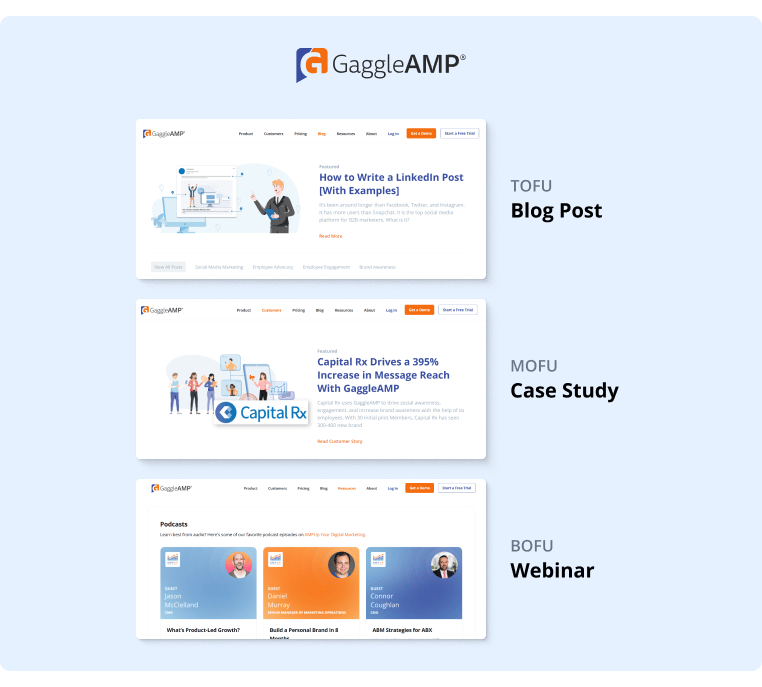
If you’re still struggling to move your TOFU users to the MOFU stage, ask yourself these questions:
- Is the TOFU content related to a pain point that your product solves?
- Do you have a clear call to action to the MOFU content? (Tip: ideally add two to three throughout the blog post.)
- Is the MOFU content the next step in their journey after consuming your TOFU content, or do they have different questions? (You might need to talk to customers to determine the answer to this question.)
How To Measure TOFU Marketing Success
TOFU marketing is difficult to track because TOFU audiences aren't designed to convert into leads immediately.
Therefore, while TOFU marketing should ultimately increase lead volume and reduce customer acquisition costs, it won't happen overnight. In addition, plenty of other variables unrelated to your TOFU marketing strategy can also impact lead volume, cost, and quality.
While it's important to pay attention to lead volume, cost, and quality, it's essential to look at other metrics directly impacted by the effectiveness of your TOFU marketing strategy.
Here are just a few of those metrics:
- Website traffic.
- Brand query search volume.
- Content and ad click-through rates.
- Engagement, interactions, and brand mentions on social media.
- Referral and direct traffic.
- Conversion quality.
- Dark social mentions, as reported by customers.
If all of these metrics are trending in the right direction, there's a good chance that you'll start seeing a reduction in customer acquisition costs, more pipeline volume, and a general increase in sales.
If not, reassess your TOFU strategy to ensure that:
-
Your TOFU audience is converting into MOFU audiences.
-
Your TOFU marketing efforts are attracting an audience with pain points that your product or service solves.
Next Steps To Improve Your Top of Funnel Strategy
As we outlined above, there are plenty of ways to improve your top of the funnel strategy, and choosing where to start can be overwhelming.
Instead, look for opportunities that require the least effort for the highest returns.
We've found that employee advocacy is one of those low hanging fruit opportunities as it doesn't cost your company anything to ask employees to share content (other than the cost of a platform), and the returns are truly outstanding as your executives and employees often have high value connections.
Our founder believes that employee advocacy is so valuable that he ultimately founded GaggleAMP, an all-in-one employee advocacy platform that allows you to assign, manage, and track employee advocacy activities at scale.
You can learn more about how GaggleAMP works by reading more about our platform or scheduling a demo.










